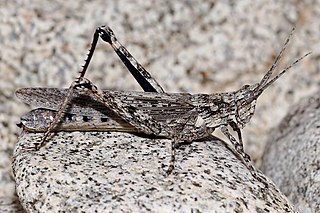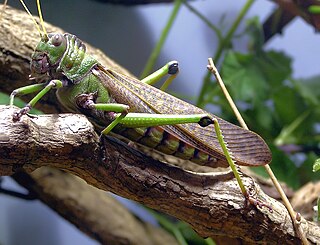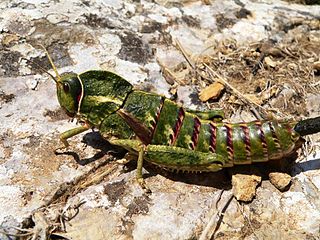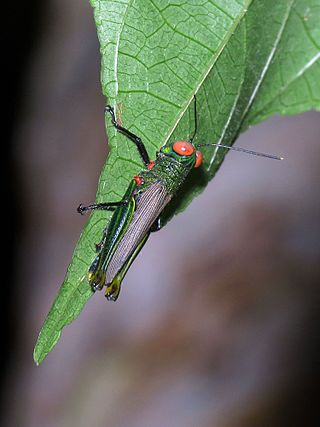
Acrididae are the predominant family of grasshoppers, comprising some 10,000 of the 11,000 species of the entire suborder Caelifera. The Acrididae are best known because all locusts are of the Acrididae. The subfamily Oedipodinae is sometimes classified as a distinct family Oedipodidae in the superfamily Acridoidea. Acrididae grasshoppers are characterized by relatively short and stout antennae, and tympana on the side of the first abdominal segment.

The grasshopper subfamily Acridinae, sometimes called silent slant-faced grasshoppers, belong of the large family Acrididae in the Orthoptera: Caelifera.

The Romaleidae or lubber grasshoppers are a family of grasshoppers, based on the type genus Romalea. The species in this family can be found in the Americas. It is known to be polyphagous, but there is not much else known regarding its diet.

Ectodus descampsii is a species of cichlid fish endemic to Lake Tanganyika in East Africa where it prefers areas with substrates of coarse sand. It feeds on micro-organisms, algae and diatoms. This species reaches a length of 10.4 centimetres (4.1 in) TL. It is also found in the aquarium trade. It is currently the only known member of its genus. The specific name honours Capitaine Georges Descamps (1855-1938), a Belgian officer in the anti-slavery movement at Lake Tanganyika.

Eumastacidae are a family of grasshoppers sometimes known as monkey- or matchstick grasshoppers. They usually have thin legs that are held folded at right angles to the body, sometimes close to the horizontal plane. Many species are wingless and the head is at an angle with the top of the head often jutting above the line of the thorax and abdomen. They have three segmented tarsi and have a short antenna with a knobby organ at the tip. They do not have a prosternal spine or tympanum. Most species are tropical and the diversity is greater in the Old World. They are considered primitive within the Orthoptera and feed on algae, ferns and gymnosperms, the more ancient plant groups.

Eumastacoidea is a superfamily within the order Orthoptera, suborder Caelifera. The family has a mainly tropical distribution and have sometimes been called "monkey grasshoppers".

Chorotypidae is a family of tropical Asian grasshoppers, formerly included within the family Eumastacidae. These grasshoppers have a head that rises above the level of the thorax and short antennae. Some species have reduced wings, others have wings that widen towards the tips and still others have a flattened leaf-like shape. They lack abdominal tympani.

The Thericleidae are a family of grasshoppers within the order Orthoptera and superfamily Eumastacoidea. They have exceptionally stubby antennae even for the Caelifera, with most species having a characteristic "horse-headed" look in profile.
The Morogoro pretty grasshopper is a species of thericleid orthopteran that is endemic to lowland and submontane rainforests around Morogoro in Tanzania. It has not been recorded since 1939 and is possibly extinct. If it is still extant, it is threatened by deforestation and conversion to agricultural land.
Pseudoterinaea bicoloripes is a species of beetle in the family Cerambycidae. It was described by Maurice Pic in 1926.
Menesida bicoloripes is a species of beetle in the family Cerambycidae. It was described by Maurice Pic in 1925.
Euschmidtiidae is a family of grasshoppers in the order Orthoptera. There are at least 60 genera and more than 240 described species in Euschmidtiidae, found in Sub-Saharan Africa and surrounding islands.

Acinipe is a genus of grasshoppers in the family Pamphagidae. There are more than 20 described species in Acinipe, found in Southern Europe and North Africa.

Pamphagus is a genus of grasshoppers in the family Pamphagidae. There are about 12 described species in Pamphagus, found in southern Europe and northern Africa.

Proctolabinae is a subfamily of grasshoppers in the family Acrididae. There are more than 20 genera and 210 described species which are found in South America.

Stenopola is a genus of spur-throat toothpick grasshoppers in the family Acrididae. There are about 13 described species in Stenopola, found in the Americas.

Euchorthippus chopardi, the Iberian straw grasshopper, is a species of slant-faced grasshopper in the family Acrididae. It is found in Europe.

The Ommatolampidinae are a subfamily of grasshoppers in the family Acrididae, found in central and South America, and based on the type genus Ommatolampis. Derived from the "Ommatolampides" used by Brunner von Wattenwyl in 1893, the first use of the name in its current form was by Rodríguez et al. in 2013; this taxon appears to be paraphyletic.

Eumastax is the type genus of grasshoppers in the family Eumastacidae, erected by Malcolm Burr in 1899 and found in of South America.













